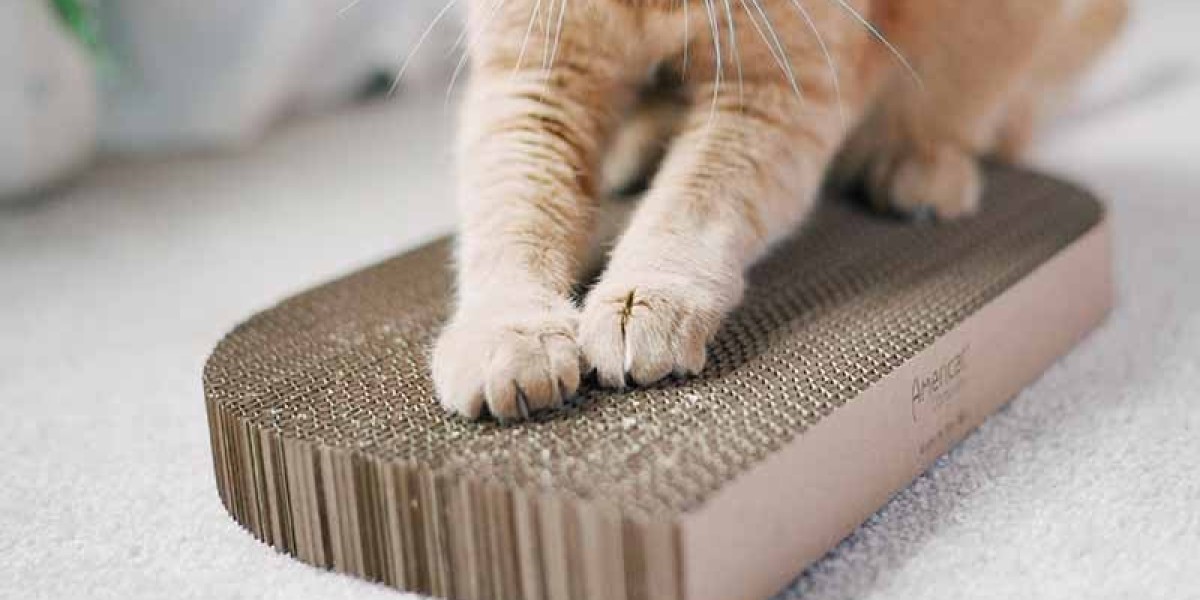If you’re a cat parent, chances are you’ve already dealt with the inevitable consequences of feline scratching—frayed sofas, clawed rugs, and damaged furniture. But instead of seeing scratching as a nuisance, it’s time to embrace it as a natural and essential feline behavior. One of the easiest and most affordable ways to channel that behavior appropriately is with a cat cardboard scratcher.
In this guide, we’ll dive deep into what makes cardboard scratchers so popular among cat owners, why cats are instinctively drawn to them, their benefits, types, and how to pick the right one for your pet. By the end, you’ll see why this simple yet effective tool can be a game-changer for your cat—and your home.
Why Do Cats Scratch?
Before we get into why cardboard makes a great material for scratchers, let’s understand why cats scratch in the first place. Scratching is not a behavioral problem; it’s an instinctive need. Here's what scratching helps cats do:
1. Maintain Healthy Claws
Scratching removes the outer dead layers of a cat's claws, keeping them sharp and healthy. It’s a natural grooming behavior.
2. Mark Territory
Cats have scent glands in their paws. When they scratch, they leave both a visible mark and a scent marker that signals ownership to other animals.
3. Exercise and Stretch
Scratching helps cats stretch their muscles and ligaments, especially in the back, shoulders, and legs. It also engages their claws and keeps them physically active.
4. Relieve Stress and Frustration
Scratching serves as a form of emotional release. It helps reduce stress, boredom, and anxiety—especially for indoor cats.
What Is a Cat Cardboard Scratcher?
A cat cardboard scratcher is a scratching surface made primarily from layers of corrugated cardboard. The texture and resistance of cardboard are very appealing to cats, mimicking the feeling of tree bark or other natural materials they would scratch in the wild.
These scratchers are typically lightweight, eco-friendly, recyclable, and come in various shapes, sizes, and designs—from simple flat pads to intricate loungers and towers.
Why Are Cardboard Scratchers So Popular?
Among all types of scratchers—sisal, carpet, wood—cardboard scratchers consistently rank as a top choice among cat owners. Here’s why:
1. Highly Appealing Texture
Cats love the feel of corrugated cardboard. It offers just the right amount of resistance and a satisfying shredding sensation that encourages repeat use.
2. Affordable
Cardboard scratchers are often less expensive than other types of scratchers, making them ideal for pet owners on a budget.
3. Eco-Friendly
Most cardboard scratchers are made from recycled materials and can be disposed of responsibly, making them a sustainable choice.
4. Lightweight and Portable
You can easily move cardboard scratchers from room to room, helping you redirect your cat’s scratching behavior wherever needed.
5. Replaceable
Unlike fixed structures, cardboard scratchers are inexpensive to replace when worn out.
6. Doubles as a Lounge
Many designs function as both scratchers and loungers, offering your cat a comfy spot to rest and scratch.
Types of Cat Cardboard Scratchers
Cardboard scratchers come in many styles to accommodate different feline preferences and household needs. Here are some popular types:
1. Flat Scratch Pads
These lie directly on the floor and are suitable for cats who prefer horizontal scratching. They’re simple, effective, and usually reversible for longer life.
2. Inclined or Angled Scratchers
These provide a sloped surface, allowing cats to scratch at a more natural angle. Great for kittens or senior cats who may find vertical scratchers challenging.
3. Lounger Scratchers
These are designed in curved or oval shapes, offering a dual function: a scratching surface and a resting area. Many cats love to nap on their loungers.
4. Box or Tunnel Scratchers
These provide a cozy enclosed space for cats to hide, nap, or play while also scratching the interior walls. Excellent for shy or anxious cats.
5. Wall-Mounted Cardboard Panels
While less common, some cardboard scratchers can be mounted vertically to the wall, saving floor space and offering vertical scratching options.
How to Choose the Best Cardboard Scratcher for Your Cat
Not all cardboard scratchers are created equal. Consider the following when selecting the perfect one:
1. Your Cat’s Scratching Style
Some cats prefer vertical scratching, while others like horizontal surfaces. Observe your cat’s behavior before choosing.
2. Durability
Look for high-density cardboard with tight corrugation. This will last longer and hold up better to daily use.
3. Size
Ensure the scratcher is large enough for your cat to stretch and scratch comfortably. Too-small scratchers may not get used.
4. Stability
Although lightweight, a good scratcher should stay in place while your cat is using it. Some models include rubber grips or non-slip bases.
5. Design and Aesthetic
Choose a style that matches your home decor if the scratcher will be in a visible area. Many brands now offer modern, minimalist designs.
6. Eco-Friendly Materials
Opt for scratchers made from non-toxic adhesives and recycled cardboard for a more sustainable choice.
Tips for Getting Your Cat to Use a Cardboard Scratcher
Even though most cats love cardboard, some may need a little encouragement. Here's how to get your cat started:
1. Use Catnip
Sprinkle dried catnip or spray catnip oil on the scratcher to attract attention. Some scratchers come pre-infused with catnip.
2. Location Matters
Place the scratcher near your cat’s favorite resting spot or close to furniture they’ve scratched before.
3. Interactive Play
Use toys to guide your cat’s paws onto the scratcher during playtime.
4. Positive Reinforcement
Reward your cat with treats or affection when they use the scratcher correctly.
5. Block Old Scratching Zones
Cover previously scratched furniture or apply deterrent sprays to redirect your cat to the new scratcher.
Maintaining and Replacing a Cardboard Scratcher
Over time, your cardboard scratcher will wear down. Here’s how to maintain it and know when it’s time to replace:
Maintenance Tips:
Flip reversible scratchers regularly to extend their life.
Remove loose cardboard flakes to keep the area tidy.
Vacuum around the scratcher to remove debris.
When to Replace:
If the scratcher is heavily shredded and no longer provides resistance.
If your cat loses interest or avoids it.
When the scratcher no longer maintains its shape or stability.
Many brands now offer refillable scratchers, allowing you to replace just the inner pad while keeping the frame—saving money and reducing waste.
DIY Cardboard Scratchers: Are They Worth It?
Yes—if you enjoy crafting and have access to leftover cardboard, you can build your own scratcher at home. Here’s a simple method:
What You Need:
Lots of corrugated cardboard
Ruler and utility knife
Non-toxic glue
Heavy-duty tape (optional)
Steps:
Cut cardboard into equal strips (usually 3–4 inches wide).
Roll the strips tightly or stack them side by side.
Glue and compress until firm.
Wrap in paper or fabric if desired.
Homemade scratchers are customizable and eco-friendly but may not be as durable or neat as store-bought models.
Benefits of Cardboard Scratchers for Cats and Owners
For Cats:
Provides a satisfying outlet for natural instincts
Encourages exercise and activity
Reduces stress and anxiety
Prevents overgrown or ingrown claws
For Owners:
Protects furniture and home interiors
Budget-friendly
Easy to replace and maintain
Environmentally responsible
Often doubles as a rest or play area
Common Myths About Cardboard Scratchers
Myth 1: Cardboard Is Too Weak to Last
Truth: High-quality, high-density cardboard lasts surprisingly long, especially when used by one or two cats.
Myth 2: All Cats Prefer Sisal or Carpet
Truth: Many cats prefer cardboard due to its texture and the sound it makes while scratching.
Myth 3: Cardboard Scratchers Are Ugly
Truth: Modern designs are sleek, stylish, and even decorative. Some resemble furniture or artwork.
Myth 4: Cheap Means Low Quality
Truth: Cardboard scratchers are affordable by nature, but some are made with premium materials and are very well-constructed.
Final Thoughts
The cat cardboard scratcher is a simple, inexpensive, and effective way to enrich your cat’s life while protecting your home. With their satisfying texture, affordability, and eco-friendly construction, it’s no wonder cats and owners alike love them. Whether your cat is a playful kitten, a senior who enjoys lounging, or a high-energy hunter, there’s a cardboard scratcher out there that fits their needs.
From flat pads to curved loungers and everything in between, cardboard scratchers combine functionality with fun. By understanding your cat’s preferences and offering them a dedicated space to scratch, you promote a healthier, happier home for both of you.
For top-rated cardboard scratchers, expert tips, and cat care product reviews, be sure to check out LifeGizmoHub—your go-to destination for smart pet parenting.








